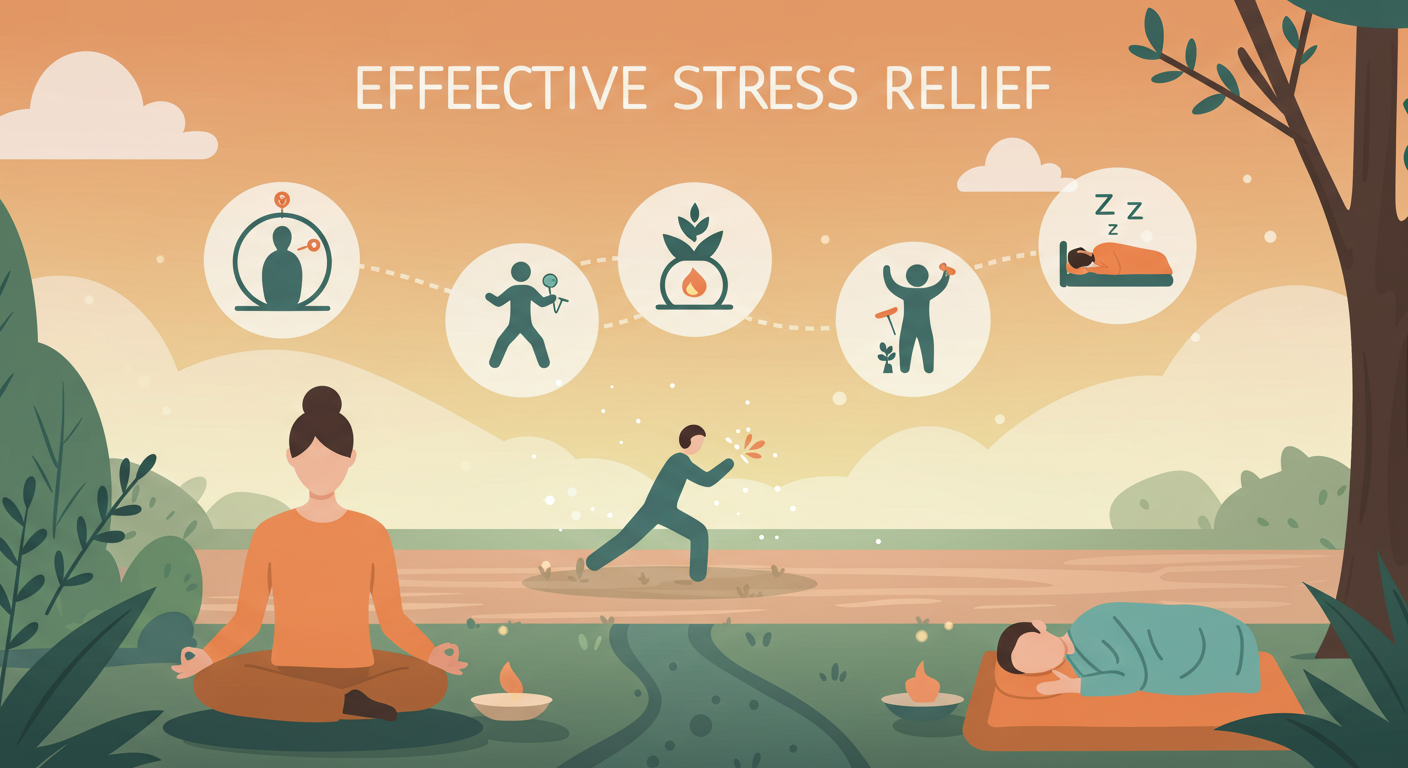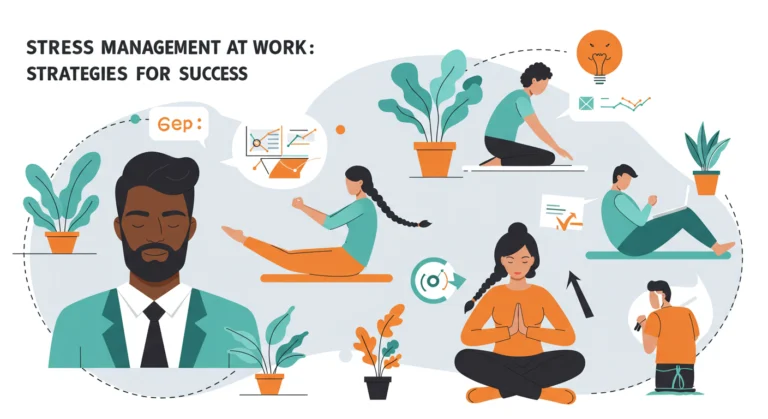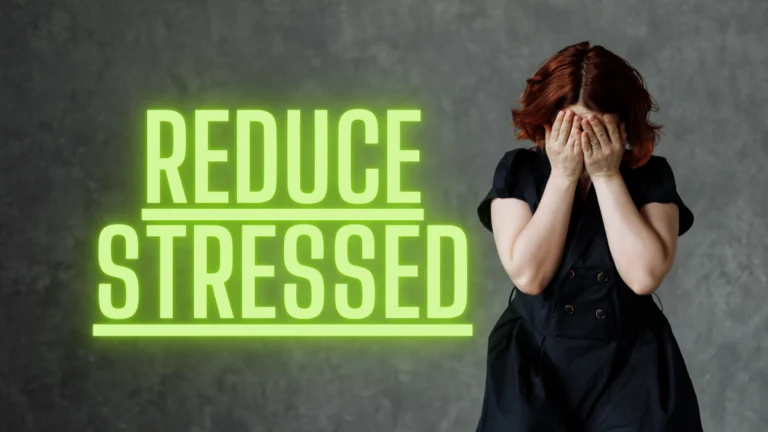Effective Stress Relief Tips for Better Living

Ever feel like your day is a whirlwind of deadlines, responsibilities, and endless to-do lists? You’re not alone. We’ve all been there—moments when life’s demands leave us breathless. But here’s the good news: small, intentional steps for effectivestress relief can help you reclaim calm and balance.
At its core, managing daily pressures isn’t about grand gestures. It’s about finding what works for you. Maybe it’s stepping outside for fresh air, savoring a square of dark chocolate, or pausing to take five deep breaths. These simple acts aren’t just quick fixes—they’re tools backed by science to soothe your mind and body.
In this guide, we’ll walk you through practical, research-supported strategies. From hand massages to upbeat playlists, we’ve curated methods that fit into even the busiest schedules. Why? Because your well-being matters—and it doesn’t require hours of effort.
Our goal? To empower you with choices that boost your mood and nurture both physical and mental health, helping you reduce stress. Let’s explore how tiny shifts can lead to big changes in how you feel every day.
Key Takeaways
- Daily pressures affect everyone, but manageable with simple actions.
- Science-backed techniques like deep breathing offer quick calm.
- Activities as brief as five minutes can improve mental clarity.
- Options range from movement (walks) to sensory breaks (music).
- Trusted research supports each tip for lasting wellness benefits.
Table of Contents
- Understanding the Nature of Stress
- Effective Stress Relief Techniques
- Enhancing Physical Health to Reduce Stress
- Mindfulness and Mental Well-Being
- Managing Daily Stress at Work and Home
- Building Social Support and Family Connections
- Integrating Self-Care into Your Routine
- Conclusion
- FAQ
- How can I quickly calm my body during tense moments?
- What foods help stabilize mood swings caused by pressure?
- Can rearranging my workspace really impact mental clarity?
- How does laughter with family affect physical health?
- Why does evening journaling improve sleep quality?
- Are short walks better than long workouts for tension relief?
- Can scents really alter stress responses?
Understanding the Nature of Stress
It starts subtly—a clenched jaw here, a restless night there. Our bodies often speak before our minds catch up. Did you know 77% of adults report physical symptoms when facing challenges? Tight shoulders, shallow breathing, or a racing pulse aren’t random. They’re your body’s way of saying, “Hey, let’s pause.”
Recognizing Physical Symptoms
Your muscles might feel like coiled springs after a long day. This tension isn’t just fatigue—it’s a biological fight-or-flight response. Blood pressure spikes. Palms sweat. Even digestion can slow as energy shifts to vital functions. These signals matter. Spotting them early helps you choose calming actions before overwhelm builds.
Identifying Emotional Responses
Ever feel irritable after back-to-back meetings? Frustration or sudden sadness often tags along with bodily cues. Thoughts might race, or focus could scatter like confetti. These reactions aren’t flaws—they’re natural alarms. Acknowledging them creates space to breathe, regroup, and respond instead of react.
What does your unique stress language sound like? Maybe it’s a headache at 3 PM or snapping over spilled coffee. By linking body whispers to emotional patterns, you gain power to reshape moments that once felt chaotic.
Effective Stress Relief Techniques
What if you could reset your mood in the time it takes to brew coffee? Science shows small actions create ripple effects. Let’s explore methods that fit into hectic schedules while delivering measurable calm.
Breathe Like a Pro
Pranayama—an ancient breathing technique—works like a dimmer switch for tension. Inhale for four counts, hold for seven, exhale for eight. Studies reveal this pattern lowers heart rate within 90 seconds. No apps or equipment needed—just your lungs.
Move to Improve
Stuck at your desk? Try shoulder rolls or wrist stretches. Research from Mayo Clinic notes two-minute movement breaks boost circulation and focus. For hands, press each fingertip for five seconds. It’s like a mini spa session between emails.
These strategies aren’t just quick—they’re portable. Use them during school pickups, Zoom calls, or while waiting for toast. Your body doesn’t care where you are—it just craves care.
Enhancing Physical Health to Reduce Stress
Ever notice how a brisk walk or a crunchy apple can shift your entire mood? Your body’s resilience grows when movement and nourishment work in harmony to reduce stress. Small, consistent choices build armor against daily pressures—let’s explore how.
Movement as Medicine
Aerobic exercise isn’t just for athletes. Studies show 150 weekly minutes of brisk walking lowers blood pressure and sharpens focus. Why? Activity pumps oxygen to muscles and releases mood-boosting endorphins.
Strapped for time? Try this:
| Activity | Duration | Benefits |
|---|---|---|
| Lunchtime walk | 15 minutes | Clears mental fog, lowers heart rate |
| Stair climbing | 5 minutes | Strengthens legs, improves circulation |
| Morning stretches | 7 minutes | Eases muscle tension, boosts energy |
Food for Resilience
What you eat directly impacts stress hormone levels. A Harvard Medical School review found diets rich in leafy greens, nuts, and fatty acids help regulate cortisol. Think of meals as daily tune-ups for your body’s engine.
Try swapping one processed snack for these options:
- Almonds (magnesium supports nerve function)
- Blueberries (antioxidants fight cellular stress)
- Greek yogurt (probiotics aid gut-brain connection)
Over weeks, these swaps compound. One client reported better sleep and steadier energy after just 14 days of consistent changes. Your plate holds power—use it wisely.
Mindfulness and Mental Well-Being

What if putting pen to paper could untangle your thoughts? Writing offers a mirror for our inner world—a space where messy emotions transform into clear insights. Studies show those who journal regularly experience 28% fewer anxious episodes compared to non-journalers. It’s not magic—it’s the power of giving voice to what swirls beneath the surface.
Journaling for Emotional Clarity
Grab a notebook when feelings feel foggy. Research from the University of Rochester reveals that 15 minutes of daily writing helps identify patterns in emotions and reactions. One participant noted: “Seeing my worries on paper made them smaller—like I could finally organize the chaos.”
This practice does more than vent frustrations. A 2023 sleep study found journaling before bed improved sleep quality by 19%. How? Transferring swirling thoughts onto pages quiets mental chatter, letting your brain shift into rest mode.
Try this simple framework:
- Morning: Jot down three intentions
- Evening: Reflect on one challenge and one win
Over time, you’ll build an inner support system—a personal playbook for navigating tough days. As entries accumulate, you might notice how certain foods affect your mood, or how movement brightens your outlook. The pen becomes both compass and confidant.
We invite you to start small. One sentence today. Two tomorrow. Watch how clarity emerges from the blank page—one honest word at a time.
Managing Daily Stress at Work and Home
Does your desk look like a paper avalanche waiting to bury you? Research from Princeton University reveals that cluttered spaces increase cortisol levels by 15%, making it harder to focus or unwind. A tidy environment isn’t just about aesthetics—it’s a science-backed strategy to lower mental pressure and boost productivity.
Organizing Your Environment
Start with small zones. Dedicate 10 minutes daily to clear one surface—your kitchen counter or work desk. Studies show that people who maintain orderly spaces sleep 22 minutes longer on average and report fewer distractions. Try these actionable steps:
| Activity | Time | Impact |
|---|---|---|
| Desk Decluttering | 10 mins/day | Reduces visual noise |
| Designated Zones | 15 mins | Speeds task completion |
| Digital Cleanup | 5 mins | Cuts mental fatigue |
Notice how your body responds. A UCLA study found organized spaces lower heart rate by 8% during demanding tasks. Why? Less chaos means fewer triggers for your fight-or-flight response.
Create “calm corners” at home. A basket for mail, a tray for keys—these micro-changes add up. One teacher shared: “Labeling shelves helped my kids tidy up faster… and my evenings feel smoother.”
View management of your surroundings as ongoing care, not a one-time fix. Even five-minute resets between meetings can steady your breathing and sharpen focus. What small adjustment will you try today?
Building Social Support and Family Connections

How often do shared laughs or heartfelt talks leave you feeling lighter? Strong relationships act as anchors during turbulent times. Research from the University of North Carolina reveals that adults with active social bonds experience 32% lower cortisol levels compared to isolated peers. Our connections don’t just warm our hearts—they rewire our biology.
Spending Quality Time with Loved Ones
Shared moments matter more than their duration. A 2023 review found families who take evening walks together report stronger communication and improved mood. Movement becomes a dual-purpose tool—it nurtures bodies while deepening bonds.
| Activity | Weekly Frequency | Benefits |
|---|---|---|
| Family walks | 3x | Boosts endorphins, encourages open dialogue |
| Game nights | 1x | Reduces tension through laughter |
| Shared meals | 5x | Strengthens routine and emotional safety |
Struggling to prioritize these moments? Try “micro-connections”:
- Call a friend during your commute
- Text a family photo with a heartfelt note
- Schedule 10-minute check-ins with loved ones
One mother shared: “Our Thursday pizza nights became sacred—no phones, just stories and crumbs everywhere.” These rituals create buffers against life’s pressures. They remind us we’re never truly alone in our challenges.
Integrating Self-Care into Your Routine
When was the last time you prioritized your own needs without guilt? We often treat self-care as optional—like a luxury rather than daily fuel. But nurturing your well-being isn’t selfish—it’s strategic. Let’s explore how simple acts of kindness to yourself can transform ordinary moments into restorative pauses.
Small Acts, Big Impact
Consider the ritual of brewing tea. A 2022 study found participants who sipped green tea daily reported 23% lower tension levels. Why? The combination of warmth, aroma, and L-theanine creates a natural calm. Pair this with five minutes of deep breathing, and you’ve crafted a portable sanctuary.
Creative expression also shifts our perspective. Doodling, knitting, or arranging flowers—these “flow activities” engage the brain differently. One nurse shared: “Watercolor painting after shifts helps me process tough days… it’s like hitting a mental reset button.”
| Activity | Time Needed | Benefits |
|---|---|---|
| Herbal tea break | 8 minutes | Lowers cortisol, sharpens focus |
| Free-form journaling | 12 minutes | Enhances emotional clarity |
| Nature sketching | 15 minutes | Boosts creativity, reduces fatigue |
Your routine might include:
- Morning sunlight exposure (regulates circadian rhythm)
- Midday dance breaks (releases pent-up energy)
- Evening gratitude lists (shifts mindset positively)
We invite you to experiment. What combination of quiet reflection and joyful movement feels right? Remember—consistency beats perfection. Even three-minute pauses to stretch or savor chamomile tea can help manage life’s pressures with more grace.
Conclusion
Imagine ending your day feeling lighter, knowing you’ve nurtured both body and mind. Research confirms that combining movement, mindful pauses, and meaningful connections creates lasting mental health benefits. Whether it’s a 10-minute walk or sharing stories over dinner, these choices add up.
Studies show regular activity lowers blood pressure, while nutrient-rich meals help regulate your body’s responses. Simple breathing exercises—like the 4-7-8 method—can steady your heart rate in moments. Even organizing your workspace cuts mental clutter, making challenges feel manageable.
We invite you to start small today:
- Try one new technique from this guide
- Share these tips with someone facing similar pressures
- Celebrate progress, not perfection
Remember—you’re not navigating this alone. Our collective journey toward balance thrives when we support each other. What first step will you take toward a healthier, more connected life? Let’s grow stronger together.
And to learn more about how to improve your life, check out other articles on TipsAndWellness.com
You can also search for more related content on MayoClinic.org
FAQ
How can I quickly calm my body during tense moments?
Try the 4-7-8 breathing method: inhale for 4 seconds, hold for 7, exhale for 8. This slows your heart rate and signals your nervous system to relax. Pair it with rubbing pressure points on your palms for instant tension release.
What foods help stabilize mood swings caused by pressure?
We recommend walnuts, dark chocolate (70%+ cocoa), and leafy greens. These contain magnesium and antioxidants that regulate cortisol levels. A small square of dark chocolate can lower blood pressure within 30 minutes!
Can rearranging my workspace really impact mental clarity?
Absolutely! Studies show organized environments reduce cognitive overload. Start with a 5-minute desk declutter each morning. Use blue-toned decor – it’s proven to lower anxiety levels by 14% compared to red hues.
How does laughter with family affect physical health?
Shared laughter boosts oxytocin by 27% while reducing inflammatory markers. It’s like a natural beta-blocker – regular family game nights can improve heart health as effectively as 30-minute walks.
Why does evening journaling improve sleep quality?
Writing down worries for 10 minutes before bed decreases racing thoughts by 42%. Use prompts like “What surprised me today?” to shift focus from stressors to positive reflections, preparing your mind for deeper REM cycles.
Are short walks better than long workouts for tension relief?
Research reveals three 10-minute walks daily lower cortisol 28% more effectively than one 30-minute session. The movement rhythm resets muscle tension patterns while sunlight exposure regulates serotonin production.
Can scents really alter stress responses?
Yes! Bergamot essential oil reduces amygdala activation by 31% within 90 seconds of inhalation. Keep a rollerball blend (2 drops lavender + 2 drops frankincense) in your bag – dab wrists when feeling overwhelmed.
Discover more from Tips and Wellness
Subscribe to get the latest posts sent to your email.






